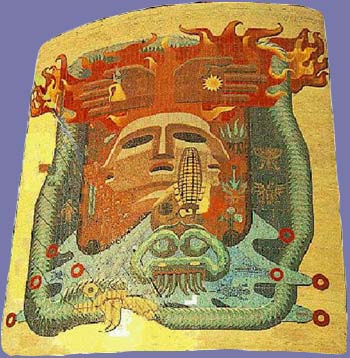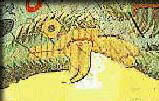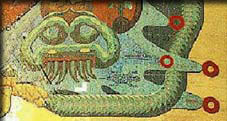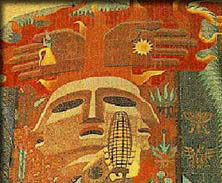School of Medicine, UNAM
| Mural | |||
As a representation of the human cosmological and theogonic conception of our indigenous ancestors, symbolized in life and death, the four elements (earth, air, fire and water) and mestizaje, Francisco Eppens made the mural of the School of Medicine in glazed ceramics. In a symbolic way, synthetic and decorative, wide and visible from a great distance. Since, because of their size, the principal figures of this mural, considered one of the most beautiful on the university campus, could prove to be too aggressive when seen close up, a concentric composition was prepared, placing the largest elements in a periphery and reducing the scale of the central ones. In this way, the work can be observed to represent a serpent biting its tail, a symbol of eternity that encompasses the whole composition, together with a skull devouring a corn cob from which, it is said, the first human being was formed.
Water is represented at the bottom by waves armed with jade discs, the chalchihuitls, that for the pre-Hispanic culture symbolized the idea of everything precious. The face of Tláloc, the god of water, showing his serpentine eyes and characteristic wheaten teeth can be seen in the midst of different water creatures like the snail, fish, water flea and axolotl.
In the air, located in the dark blue side borders, butterflies, an eagle and a cozcacuahtli or "royal vulture" can be appreciated. These are important figures representative of Aztec mythology that were for a long time the source of inspiration of the indigenous codices.
The earth, in the center at the top, symbolized by the flaccid breasts worn out from "suckling gods and men to pour life into them" of Coatlicue, the pre-Colombian earth mother, from whose breast the trees and plants are nourished. From the way they are presented in the mural they would appear to have been inspired by the Codex Badianus.
Above the face of Tláloc a profile of the image of death appears with a splendid corn cob, the symbol of life, emerging from between its teeth.
Finally, fire is expressed at the top by the flames of the Mayan suns. The center of the mural is taken up by a large head looking like a sculpture constituted by three faces joined together, one of the indigenous mother on the left, the Spanish father on the right and in the middle the face of the mestizo son; that is, present day Mexico, an idea very similar to that of Rivera's in the Olympic Stadium. Mestizaje is synthesized in the head where two outheld hands can be seen, reminiscent of the tremendous necklace of Coatlicue. In the palm of the hand, on the side corresponding to the face of the indigenous mother, there is a germinating seed and in the palm of the other hand, representing the face of the Hispanic father, fertilizing pollen can be observed.
The idea of creating this work arose in 1953 with the request of the architect, Roberto Alvarez Espinosa, which moved Francisco Eppens to design a mural for an outside wall on the university campus. This proved to be quite a challenge due to its curvature on a large façade looking over a square of spectacular dimensions. The technical problems faced in doing this mural were interesting. As the surface was curved and covered with vitricotta, the standard design of most of the façades of the University Campus, it was necessary to make the mural using small precast concrete tiles one meter long by twenty-five centimeters wide to give curvature to a wall 20 meters high by 18 meters wide at the base. These tiles were anchored to the wall, and screw thread was left on the ends of the wire rods in such a way that by perforating the wall the tiles could be screwed down at the back, while leaving the possibility of subsequently dismantling the mural. Eppens himself stated that the work was done by unskilled workmen from the University using glass mosaic that was then being produced in the "Mosaicos Venecianos de México, S.A." factory in Cuernavaca, Morelos. When the work had barely started it was found that there was no light green mosaic and there was none in the factory either. Iit was therefore necessary to buy glass plates in that tone, break them into pieces and place them in the parts of the mural where they were needed. When this splendid mural covering a large stretch of the west side of the School of Medicine, that the creator himself judged to be his best work, was finished in January 1954, it was considered to be a monumental allegory of our indigenous and Spanish past resulting in beneficial mestizaje. The creator of this beautiful piece of work was born in San Luis Potosí in 1913. He moved to the capital of the Republic where he did his primary and higher studies, going to the National School of Plastic Arts in 1928. One year later, he left that school to devote himself to painting and applied his skill to the drawing and color, first of posters, and later postage and treasury stamps. His activity in this latter aspect established a new concept in the graphic presentation of philatelic subjects in Mexico. Finally, his artistic concerns led him to muralism. Eppens was the author of the painted stretches of wall in the elevator shaft of the Children's Hospital. In 1952, he was invited by the Mechanics and Metallurgic company to do a ceramic mosaic mural on their industrial premises. The following year he designed and did the murals for the Medicine and Odontology schools of the University. From that time on, glazed ceramic mosaic decorations became the center of his artistic activities. He then did several murals and in 1962 was awarded first prize in the competition for mosaic murals of the new building of the Institutional Revolutionary Party that he did the following year. In 1968, upon the request of Luis Echeverría Alvarez, Minister of the Interior, the artist designed the National Coat of Arms in black and white for printed material, in high relief for coins and in color for our national banner and also created the model for the national Flag whose originals were deposited in the National Palace, the General Archives of the Nation, the Mint and Chapultepec Castle. As the architect, Héctor Ceballos Lascurain, pointed out the mosaic mural of the School of Medicine has become one of the most distinctive architectural elements of that building. This magnificent mural constitutes the focal point of the wide esplanade in front of the School. Even seen from a distance, from the open urban spaces of the University Campus, the vigorous strokes, the concentrated, clear composition that gives the effect of an enormous poster and the bright color of this work attract attention to one of the most successful Latin American murals. The serpent, Quetzalcóatl, modeled with surprising volumetric effects, frames the whole composition and effectively delimits the façade of this important building, the School of Medicine. Source: Gaceta UNAM 4 November,
1993 | |||







